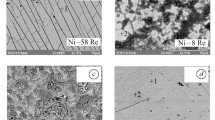We propose the optimal composition of a polyligand ammonium-chloride-fluoride electrolyte and a mode of electrolysis for the deposition of functional coatings formed by tin–nickel alloys. The tin–nickel alloy with a tin content of 65 wt.% and a nickel content of 35 wt.% proves to be the most promising for microelectronics in the case of its application instead of gold coatings. It is shown that the obtained coatings are suitable for soldering with the use of low-temperature solders and acid-free fluxes and for the ultrasonic spot welding. The electrolytic deposits of tin–nickel alloys are investigated as the anodes of lithium–ion batteries by the potentiodynamic and galvanostatic cycling methods. It is shown that the deposits obtained from an alkaline tartrate-trilonate electrolyte are characterized in the first cycles by a high specific capacity of up to 700 mA ∙ h/g. In the course of cycling, this parameter decreases to 500 mA ∙ h/g. The obtained tin–nickel alloys guarantee high densities of charge-discharge currents without mechanical fracture.






Similar content being viewed by others
References
N. I. Globa, V. D. Prisyazhnyi, V. S. Kublanovsky, and V. N. Nikitenko, “Investigation of electrolytic tin-nickel alloys as anode materials for lithium-ion batteries,” Surf. Eng. Appl. Electrochem., 50, No. 3, 280−284 (2014).
M. Hansen and K. Anderko, Constitution of Binary Alloys, McGraw-Hill, New York (1958).
R. P. Elliott, Constitution of Binary Alloys, First Supplement, McGraw-Hill, New York (1968).
H. Enomoto, Y. Fujiwara, M. Izaki, and H. Ono, “Relationship between thermal stability and alloy composition of metastable tin–nickel electrodeposits,” J. Metal. Finish. Soc. Japan, 33, No. 8, 369–374 (1982).
V. N. Nikitenko and V. S. Kublanovsky, “Functional electrolytic coatings by tin–nickel alloys,” Ukr. Khim. Zh., 81, No. 7, 58−61 (2015).
O. L. Bersirova and V. S. Kublanovsky, “Corrosion properties of electrodeposited thin coatings of polycrystalline silver,” Fiz.-Khim. Mekh. Mater., 48, No. 2, 71–76 (2012); English translation : Mater. Sci., 48, No. 2, 197–202 (2012).
I. Amadei, S. Panero, B. Scrosati, G. Cocco, and L. Schiffini, “The Ni3Sn4 intermetalic as novel electrode in lithium cells,” J. Power Sources, 143, 227–230 (2005).
L. Huang, H. B. Wei and F.-Sh. Ke, “Electrodeposition and lithium storage performance of three-dimension porous reticular Sn–Ni alloy electrodes,” J. Electrochem. Acta, 54, 2693–2698 (2009).
K. Nishikawa, K. Dokko, K. Kinoshita, S.-W. Woo, and K. Kanamura, “Three-dimensionally ordered macroporous Ni–Sn anode for lithium batteries,” J. Power Sources, 189, No. 10a, 726–729 (2009).
Author information
Authors and Affiliations
Corresponding author
Additional information
Translated from Fizyko-Khimichna Mekhanika Materialiv, Vol. 52, No. 5, pp. 77–82, September–October, 2016.
Rights and permissions
About this article
Cite this article
Kublanovsky, V.S., Nikitenko, V.M. & Globa, N.I. Electrochemical Deposition of Corrosion-Resistant Coatings from Tin–Nickel Alloys. Mater Sci 52, 687–693 (2017). https://doi.org/10.1007/s11003-017-0010-1
Received:
Published:
Issue Date:
DOI: https://doi.org/10.1007/s11003-017-0010-1



